Summary
-
1.
A study was made of the catalytic and adsorptive properties of magnesium oxide samples containing additions of stannic oxide introduced in quantities of 0.01–6.4% by various methods: by application to prepared magnesium oxide via organic and inorganic tin compounds, and by coprecipitation.
-
2.
It was shown that the introduction of stannic oxide into magnesium oxide by impregnation with tetraphenyl tin or stannic chloride results in a modification of the action of the magnesium oxide catalyst in the decomposition of hydrogen peroxide. The main effect is already brought about by the very smallest additions of stannic oxide. As the temperature of the catalytic process is lowered from 90° to 5° , the modification curves change in form, becoming flattened out.
-
3.
The dependence on stannic oxide content of the activity of catalysts prepared by the coprecipitation of magnesium and tin salts is expressed by a curve having a minimum and a maximum. Minimum catalytic activity corresponds to a stannic oxide content of 0.02% and maximum activity to a stannic oxide content of 1%.
-
4.
Change in the method of introducing the additive not only affects the catalytic properties, but also - as we showed previously-results in a marked change in the adsorptive properties of the catalyst. When stannic oxide is introduced into prepared magnesium oxide, the adsorptivity and specific surface of the sample increases with increase in additive content. When stannic oxide is introduced into magnesium oxide by coprecipitation, the adsorptivity and specific surface of the products are almost unaffected by increase in additive content.
-
5.
On the basis of a comparison of the catalytic and adsorptive properties of the catalysts studied, we have advanced the hypothesis that the ways in which additions of stannic oxide are incorporated into magnesium oxide are of two different types and that the manner in which the additions act depends on the method by which they are introduced into the catalyst.
Similar content being viewed by others
Literature cited
G. M. Zhabrova, S. Z. Rogimky, and E. A. Fokina, J. Gen. Chem., 24, 10 (1954) (T.p. 7).
O. M. Todes and L. Ya. Margolis, Bull. Acad, Sci., USSR, Div. Chem., Sci.., 1947, No.. S, 443,
L. Ya. Margolis and O. V. Krylov, J. Gen. Chem. 20, 1991 (1960) (T.p. 2063).
S. Z. Roginsky, Proc. Acad. Sci., USSR, 87, 1013 (1952).
G. M. Zhabrova, Prog. Chem., 20, 450 (1951).
A. I. Shlygin. Doctorate Thesis, Inst. Phys. Chem., Acad. Sci., USSR, Kirvo State Univ., Kazan. 1947.
N. I. Element. Candidate's Thesis, Moscow Inst. Chem., Eng., 1948.
G. M. Zhabrova, S. Z. Roginsky, and E. A. Fokina, J. Phys. Chem., 29, No. 3, 558 (1955).
Author information
Authors and Affiliations
Additional information
The authors express their thanks to S. Z. Roginsky for his constant interest in this work and to M. Ya, Kushnerev for carrying out the X-ray-structure measurements.
Rights and permissions
About this article
Cite this article
Zhabrova, G.M., Fokina, E.A. Effect of the method of making modifying additions on the properties of oxide catalysts. Russ Chem Bull 4, 879–885 (1955). https://doi.org/10.1007/BF01173955
Received:
Issue Date:
DOI: https://doi.org/10.1007/BF01173955



